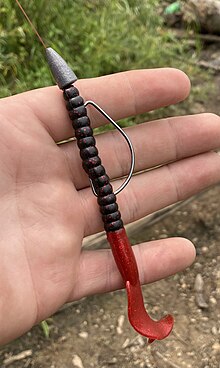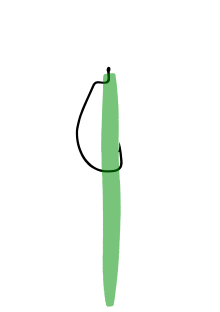
Trolling is a method of fishing where one or more fishing lines, baited with lures or bait fish, are drawn through the water at a consistent, low speed. This may be behind a moving boat, or by slowly winding the line in when fishing from a static position, or even sweeping the line from side-to-side, e.g. when fishing from a jetty. Trolling is used to catch pelagic fish such as salmon, mackerel and kingfish.

Angling is a fishing technique that uses a fish hook attached to a fishing line to tether individual fish in the mouth. The fishing line is usually manipulated via a fishing rod, although rodless techniques such as handlining also exist. Modern angling rods are usually fitted with a fishing reel that functions as a cranking device for storing, retrieving and releasing out the line, although Tenkara fishing and traditional cane pole fishing are two rod-angling methods that do not use any reel. The fish hook itself can be additionally weighted with a denser tackle called a sinker, and is typically dressed with an appetizing bait to attract and entice the fish into swallowing the hook, but sometimes an inedible fake/imitation bait with multiple attached hooks is used instead of a single hook with edible bait. Some type of bite indicator, such as a float, a bell or a quiver tip, is often used to relay underwater status of the hook to the surface and alert the angler of a fish's presence.

Recreational fishing, also called sport fishing or game fishing, is fishing for leisure, exercise or competition. It can be contrasted with commercial fishing, which is professional fishing for profit; or subsistence fishing, which is fishing for survival and livelihood.

Jigging is the practice of fishing with a jig, a type of weighted fishing lure. A jig consists of a heavy metal sinker with an attached fish hook that is usually obscured inside a soft lure or feather-like decorations. Jigs are intended to create a jerky, vertical "jumping" motion to attract fish, as opposed to other common lures like swimbaits, spoons and spinnerbaits, which move through the water more or less horizontally. The jig is very versatile and can be used in both salt and fresh water. Many deeper water fish species are attracted to the lure, which has made it popular among anglers for years.

A fishing lure is any one of a broad category of artificial angling baits that are inedible replicas designed to mimic prey animals that attract the attention of predatory fish, typically via appearances, flashy colors, bright reflections, movements, vibrations and/or loud noises which appeal to the fish's predation instinct and entice it into gulping the lure. Angling activities using lures are known as lure fishing.
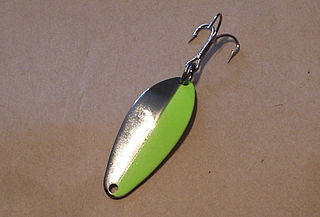
In sport fishing, a spoon lure is a fishing lure usually made of lustrous metal and with an oblong, usually concave shape like the bowl of a spoon. The spoon lure is mainly used to attract predatory fish by specular reflection of light, as well as the turbulences it creates when moving in water.

A fishing sinker or plummet is a weight used in conjunction with a fishing lure or hook to increase its rate of sink, anchoring ability, and/or casting distance. Fishing sinkers may be as small as 1 gram (0.035 oz) for applications in shallow water, and even smaller for fly fishing applications, or as large as several pounds or considerably more for deep sea fishing. They are formed into many different shapes for diverse fishing applications. Environmental concerns surround the usage of lead and other materials in fishing sinkers.

Chumming is the blue water fishing practice of throwing meat-based groundbait called "chum" into the water in order to lure various marine animals to a designated fishing ground, so the target animals are more easily caught by hooking or spearing. Chums typically consist of fresh chunks of fish meat with bone and blood, the scent of which attracts predatory fish, particularly sharks, billfishes, tunas and groupers. In the past, the chum contents have also been made from "offal", the otherwise rejected or unwanted parts of slaughtered animals such as internal organs.
A downrigger is a device used while fishing using the trolling method, which places a lure at the desired depth. A downrigger consists of a three to six-foot horizontal pole which supports a cannonball, generally 10 to 15 pounds, by a steel cable. A clip, also known as a "release," attaches a fishing line to the cannonball weight. The bait or lure is attached to the release.

A spinnerbait or spinner is any one of a family of hybrid fishing lures that combines the designs of a swimbait with one or more spoon lure blades. Spinnerbaits get the name from the action of the metallic blades, which passively revolve around the attachment point like a spinning propeller when the lure is in motion, creating varying degrees of vibration and flashing that mimic small fish or other preys of interest to large predatory fishes. The two most popular types of spinnerbaits are the in-line spinner and safety pin spinnerbait, though others such as the tail spinner also exist. Spinnerbaits are used principally for catching freshwater fishes such as perch, pike and bass.

Fishing tackle is the equipment used by anglers when fishing. Almost any equipment or gear used in fishing can be called fishing tackle, examples being hooks, lines, baits/lures, rods, reels, floats, sinkers/feeders, nets, spears, gaffs and traps, as well as wires, snaps, beads, spoons, blades, spinners, clevises and tools that make it easy to tie knots.

A plastic worm or trout worm is a soft-bodied fishing lure made of elastomer polymer material, generally simulating an earthworm. Plastic worms are typically impaled onto a hook, and can carry a variety of shapes, colors and sizes, awith some are even scented to simulate live bait.

Plugs are a popular type of hard-bodied fishing lure, characterized by a specially designed foil at the front end known as the bill or lip. Plugs are widely known by a number of other names depending on the country and region, including crankbait, wobbler, minnow, shallow-diver and deep-diver. The term minnow is usually used for long, slender, lures that imitate baitfish, while the term plug is usually used for shorter, deeper-bodied lures which imitate deeper-bodied fish, frogs and other prey. Shallow-diver and deep-diver refer to the diving capabilities of the lure, which depends on the size and angle of the lip, and lure buoyancy.

Soft plastic bait, commonly known as soft lure, soft plastics, plastic bait, worm lure or just worm, is any of a range of elastomer-based fishing lures termed so because of their flexible, flesh-like texture. Soft lures are available in a large range of colours, sizes and particularly shapes, and are typically impaled directly onto a fishing hook like an ordinary bait.
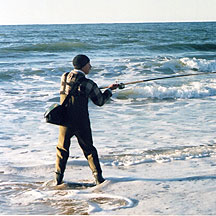
Surf fishing is land-based game fishing while standing on the shoreline or wading into the surf zone. A general term, surf fishing may or may not include casting a lure or bait, and refers to all types of shore fishing – from sandy and rocky beaches, rock jetties, or even fishing piers. The terms surfcasting or beachcasting refer more specifically to surf fishing from the beach by casting into the surf at or near the shoreline. With few exceptions, surf fishing is done in saltwater. The most common misconception about surf fishing is the idea that one must cast as far out as possible in order to reach the fish. At beaches on the west coast of the United States, and in fact, at most beaches around the world, you only really need to get your bait into knee-deep water. This is referred to as surf fishing the "skinny".

Fishing techniques are methods for catching fish. The term may also be applied to methods for catching other aquatic animals such as molluscs and edible marine invertebrates.
Drop shotting is a highly finesse angling technique using plastic baits, consisting of a small thin-wire hook with a weight (sinker) attached to the tag end of the line. This is in contrast to the more traditional Texas Rig, where the weight slides inline, resting on the nose of the bait; or the Carolina Rig, where the weight is fixed above the bait. The dropshot rig provides the ability to keep a hook and lure off the bottom with a more "weightless"-looking posture. Usually the bait is fished by letting the weight hit the bottom and then twitch the rod tip, causing the lure to shake in a jumping-like action, but can also be flipped, dragged, hopped or jigged along the bottom. This simple but versatile technique has endless combinations with the different hooks, soft plastics and weights that can be used.[1] The aim is to present a free floating, slow twitching lure to induce a strike from non-aggressive fish. This rig is commonly used in bass fishing for catching smallmouth, largemouth and spotted bass, but can be used for a variety of other bottom-dwelling fish species, as well.
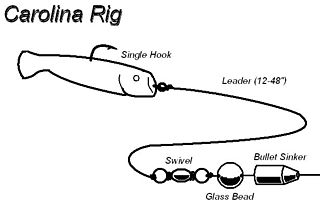
The Carolina rig is a fishing rig similar to the Texas rig, but with the sinker weight fixed above the hook instead of sliding down to it. The Carolina rig is suitable for beginning fishers, and this specific rig is designed to help fishermen catch bottom-feeding fish, particularly black bass. When placed in water, the lure attached to a Carolina rig will move in a circular motion. Bass are attracted to this movement and are therefore more likely to strike the lure. The Carolina rig also provides benefits for colder seasons, as the heavy weight on the rig allows the bait to reach deeper waters, where fish typically stay in winter months.
The following outline is provided as an overview of and topical guide to fishing:
The wacky rig is a skill technique used for fishing with a soft plastic lure, such as the Gary Yamamoto 'Senko'. Notable for its unique action even among soft lures, wacky style is used to heighten the chance at catching finicky fish on harsh days, although at the expense of lowering the chances of very large fish, because the size of the bait is very small, allowing bass of all sizes to take the bait. Unlike the Texas rig and Carolina rig, both sides of the wacky rig flutter, creating a more natural action. The name comes from its unusual style of attaching a plastic worm through the middle of the body instead of on one end.

